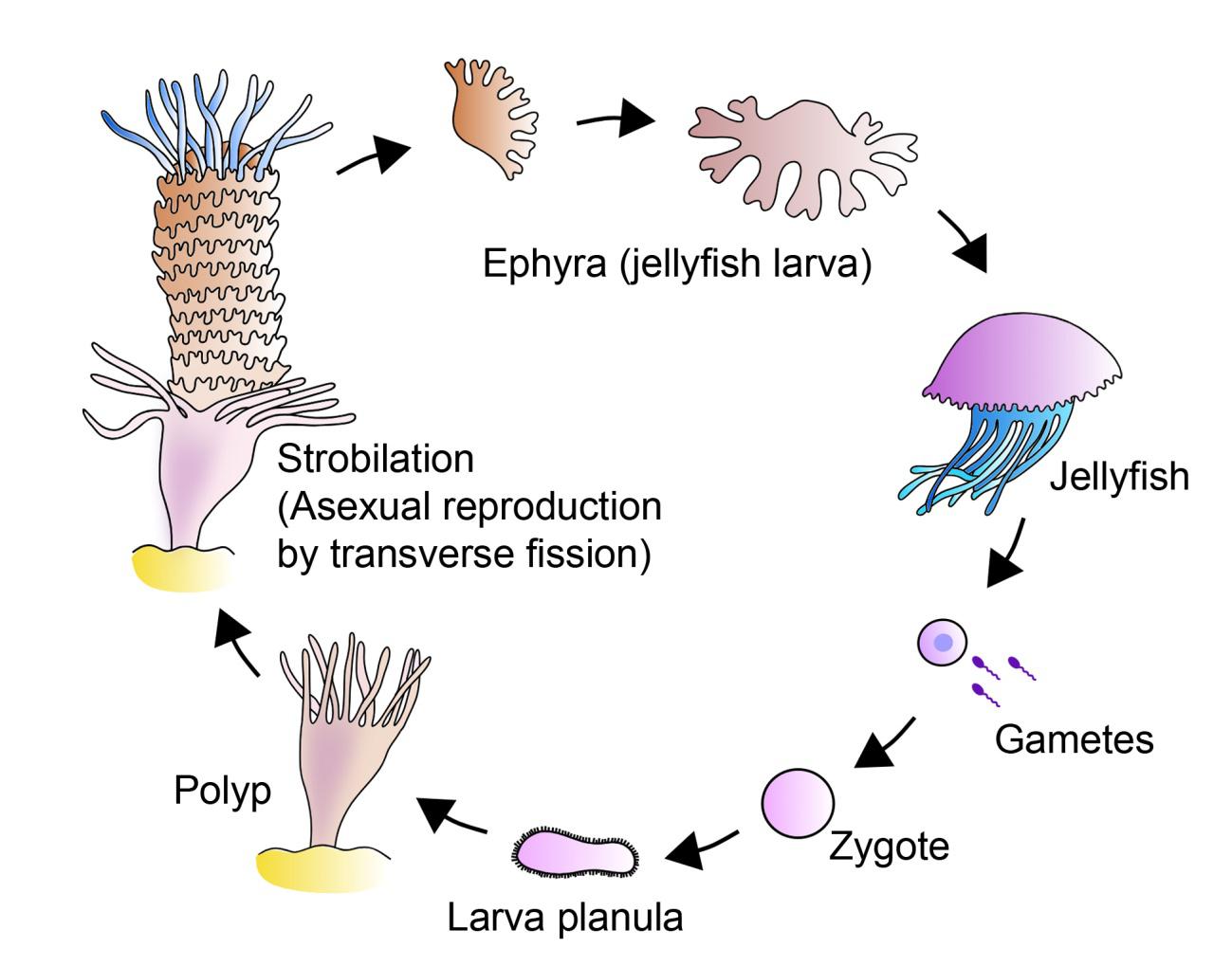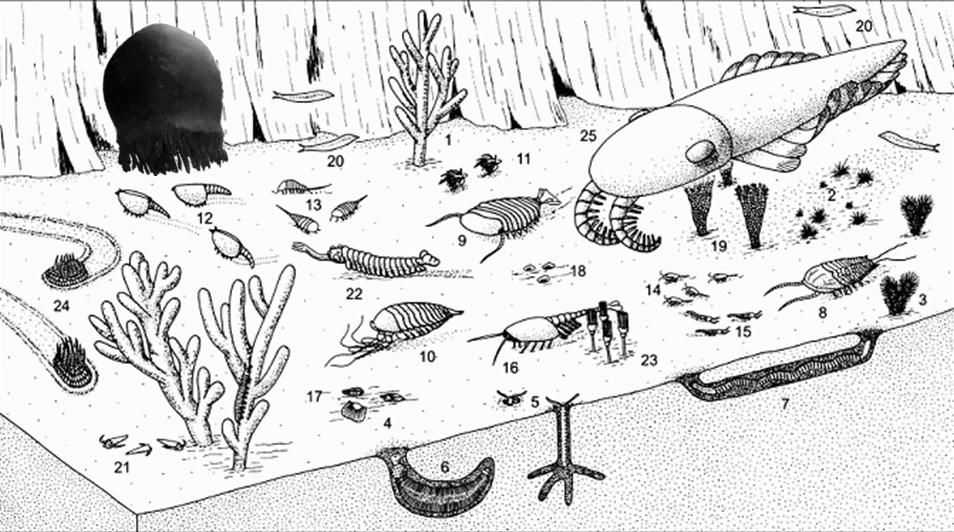The oldest known jellyfish
Author: Ramón Muñoz-Chápuli has been Professor of Animal Biology in the University of Málaga until his retirement. He has investigated for forty years in the fields of developmental biology and animal evolution.
Cnidarians (corals, hydrozoans and jellyfish) are fascinating animals. Despite their primitive organization, lacking a brain or muscles, they are efficient predators of much more complex animals than themselves. Toxic cells called cnidocytes paralyse their prey and can cause injuries if we come into contact with them. These cells are so effective that other animals retain them after consuming cnidarians and use them for their own defence 1.
Much less known but equally astonishing is the life cycle of many cnidarians, known as alternation of generations. This means that within the same species, there can be two types of individuals: the polyps, attached to a substrate, and the free-swimming jellyfish. Except in the case of corals (Anthozoans), asexual polyps give rise to jellyfish through transverse fission of their bodies. The jellyfish, which have gonads, reproduce sexually, giving rise to new polyps (Figure 1). Throughout evolution, one of these two types has predominated in different groups of cnidarians. For example, the typical jellyfish found on our beaches (Medusozoans) go through greatly reduced, microscopic polyp phases, whereas Anthozoans completely lack a jellyfish phase and reproduce both sexually and asexually.

The question we can ask is: which came first, the polyp or the jellyfish? It seems likely that polyps appeared first in evolution and developed a free-swimming jellyfish phase to disperse their populations. Current Anthozoans may have lost that jellyfish phase, which became predominant in Medusozoans. On the other hand, fossilized polyps are much more common in very ancient sediments, but there is a bias in this observation. It is much easier for a polyp living on a substrate to become buried and fossilized than for a floating jellyfish in the open sea. Additionally, polyps can develop calcareous elements that are absent in jellyfish, whose gelatinous bodies quickly decompose after the animal’s death.
Fossilized jellyfish are very rare. For this reason, the recent discovery of the oldest known jellyfish, identified in the famous Burgess Shale fossil-bearing deposit in British Columbia (Canada), has been quite remarkable. This deposit is featured in the book “Wonderful Life” by the late and brilliant Stephen Jay Gould 2. Burgess Shale changed our understanding of the early times of animal evolution and contributed to the concept of the “Cambrian explosion”. Indeed, during the transition from the Precambrian to the Cambrian period at the beginning of the Palaeozoic era, practically all major animal groups appear in the fossil record within a relatively short period of time, between 540 and 515 million years ago. This includes all current animal groups and a significant number of groups that are now extinct. Thus, the diversity of animal forms in the mid-Cambrian was enormous, and a good representation of this diversity was trapped in the Burgess Shale sediments, which are approximately 505 million years old.

Sponges: 1.- Vauxia, 2.- Choia, 3.- Pirania
Brachiopoda: 4.- Nisusia
Annelida: 5.- Burgessochaeta
Priapulida: 6.- Ottoia
Arthropoda: 8.- Olenoides, 9.- Sidneyia, 10.- Leanchoilia, 11.- Marella, 12.- Canadaspis, 13.- Molaria, 14.- Burgessia, 15.- Yohoia, 16.- Waptia
Lobopodia: 17.- Aysheaia, 22.- Opabinia 25.- Laggania
Mollusca: 18.- Scenella, 24.- Wiwaxia (uncertain)
Echinodermata: 19.- Echmatocrinus (uncertain)
Chordata: 20.- Pikaia
Hyolitha: 21.- Haplophrentis
Uncertain: 7.- Louisella, 23.- Dinomischus
It is likely that a sudden sediment avalanche combined with low oxygen concentration caused even soft bodies like jellyfish to form thin carbonaceous films in the Burgess Shale lutites. The study of these traces allowed a group of palaeontologists from the University of Toronto and the Royal Ontario Museum to publish the description of Burgessomedusa phasmiphormis, the oldest known species of a macroscopic jellyfish 3. Unlike other Palaeozoic jellyfish remains, which are either microscopic, poorly preserved or of uncertain attribution, this is a large jellyfish (up to 20 cm long, a relatively large animal in the Burgess Shale fauna, see figure 2), oblong, and equipped with around 90 short tentacles, likely armed with cnidocytes. It was undoubtedly an active predator on the benthic fauna, as whole trilobites and other arthropods have been observed inside some fossils. This is surprising because arthropods were thought to be the main predators in the mid-Cambrian seas.
Additionally, the discovery of Burgessomedusa has shown that the complex life cycle of cnidarians, with its striking alternation of generations, probably evolved during the Cambrian explosion, if not earlier.
References
- Goodheart J, Bely A. 2016. Sequestration of nematocysts by divergent cnidarian predators: Mechanism, function, and evolution. Invertebrate Biol. 136(1): 75–91. DOI: 10.1111/ivb.12154. ↩
- Gould SJ. 2000. Wonderful Life: The Burgess Shale and the History of Nature. Vintage, New York. ↩
- Moon J, Caron J-B, Moysiuk J. 2023. A macroscopic free-swimming medusa from the middle Cambrian Burgess Shale. Proc. R. Soc. B 290: 20222490. https://doi.org/10.1098/rspb.2022.2490 ↩